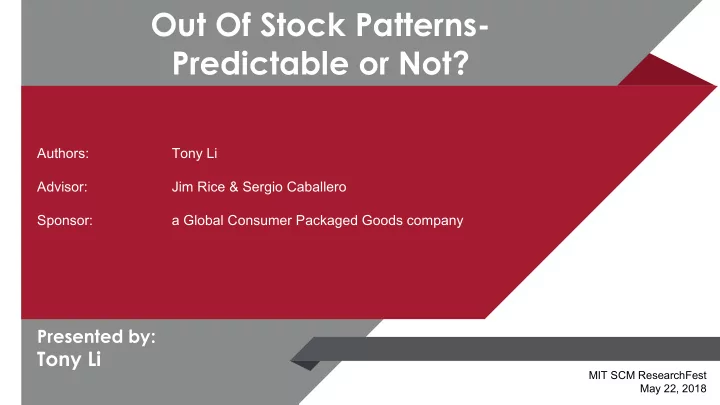

Out Of Stock Patterns- Predictable or Not? Authors: Tony Li Advisor: Jim Rice & Sergio Caballero Sponsor: a Global Consumer Packaged Goods company Presented by: Tony Li MIT SCM ResearchFest May 22, 2018
Agenda ▰ Company background & problem ▰ Data samples ▰ Methodology ▰ From 8 patterns to 3 patterns ▰ Pattern I and steep drops ▰ Future studies & Conclusion 2
Company Overview – Industry & Distribution model Industry OOS problem - Baby product - Repeated OOS - HQ in NA events at retailers’ - Manufactures DC products and - There might be stores mainly in patterns for OOS mixing centers - Goal is to identify whether there is a pattern Mixing center - Sudden vs gradual - Inbound shipments drop in the last two to mixing center days - From Mixing center - Actions to minimize to retailers’ DCs the impact of OOS - From retailers’ DCs to retailers’ stores 3
Sample data One SKU includes - 42 DCs - Each DC (one year) 432 unique SKUs - DC data - Store data 5 demand signals - Base Demand - Unexpected Demand - Phase In - Promotion - Phase Out 20 SKUs are selected: - High volume (65%) - Demand signals mix 4
Methodology – Index for three patterns § Normalize data § Matrix Profile § Interval m=7, 6, 5 or 4 Days § '()*+ !"#$% = ,-.'()(*+ 01 *+23) § Lower bound and upper bound 5
Methodology – Similarity search § Calculate the average inventory level within each subset of time series (length of subset=m); ▰ Five steps approach § Divide each inventory level by the average inventory level in order to obtain ▰ Python the index for each row; § Compare each index to the interval of the predefined index range: If each index is within the lower bound and upper bound of the predefined index range, then a pattern is identified, indicated, and recorded in the new dataset; § Slide the subset until the end of the time series in the same DC data; § Repeat the same steps for all 42 DCs’ data . 6
Example of pattern recognition for Pattern I Original time series vs aggregated Patten I Use both index and inventory on hand value 7
From 8 Patterns to 3 patterns § 5 GTINs were tested with 8 patterns § as the m value decreases from 7 days to 4 days, similar pattern shapes happen more often, § 3 higher frequency patterns were selected for further research 8
Steep drops for Pattern I § 70% drop for 7, 6 and 5 days; 80% drop for 4 days § 20 SKUs were tested § steep drops seems to be infrequent events (less than 10%) § OOS pattern doesn’t seem to be predictable sole based on DC data 9
Future studies-POS & weekends § POS>inventory starting point § Total store inventory > POS § Weekday vs weekends § Safety stock § Collaborative planning 10
Conclusions and Recommendations ▰ Using the index and similarity search methods, a series of OOS patterns can be identified and aggregated in a large scale. This method could possibly be scaled to all 432 GTINs to aggregate patterns from 4 million transactions. ▰ Stock outs don’t seem to be predictable based solely on the DC data. ▰ Store data could be incorporated to connect the POS and OOS events, in order to identify the drivers of out of stocks. 11
Thank you and questions 12
Recommend
More recommend